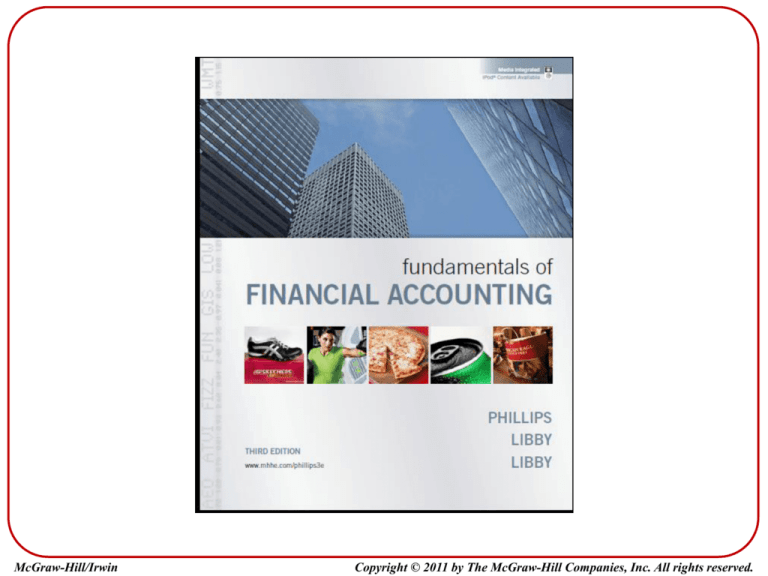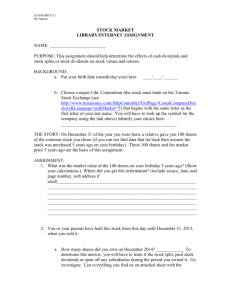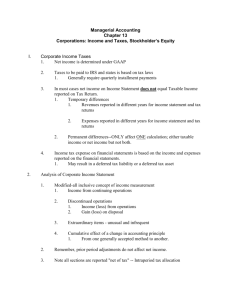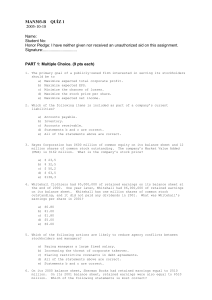
McGraw-Hill/Irwin
Copyright © 2011 by The McGraw-Hill Companies, Inc. All rights reserved.
Chapter 11
Reporting and Interpreting
Stockholders’ Equity
PowerPoint Authors:
Susan Coomer Galbreath, Ph.D., CPA
Charles W. Caldwell, D.B.A., CMA
Jon A. Booker, Ph.D., CPA, CIA
Fred Phillips, Ph.D., CA
Corporate Ownership
The major advantage of the corporate form of business
is the ease of raising capital as both large and small
investors can participate in corporate ownership.
Simple to
become an
owner
Easy to
transfer
ownership
Provides
limited
liability
Because a corporation is a separate legal entity, it can
Own assets.
Incur liabilities.
Sue and be sued.
Enter into contracts.
11-3
Corporate Ownership
Voting rights.
Dividends.
Stockholder
Benefits
Residual claims.
Preemptive rights.
11-4
Common Stock Transactions
Two primary sources of
Stockholders’ Equity
Contributed
Capital
Common
Stock
11-5
Additional
Paid-in
Capital
Retained
Earnings
Authorization, Issuance, and
Repurchase of Stock
Authorized
Shares
Issued
Shares
11-6
Outstanding shares are
issued shares that are
owned by stockholders.
Issued
Unissued
shares are
shares of
Outstanding
The maximum number
Unissued
authorized
stock are
Shares
of shares
of capital
Shares
shares
of
shares
that
be never
stockstock
that that can
have
Treasury
shares are
haveissued
been to the public.
been
Treasury
issued shares
distributed to
distributed
to that have
Shares
been reacquired by the
stockholders.
stockholders.
corporation.
Stock Issuance
Initial public offering
(IPO)
Seasoned new issue
The first time a
corporation issues
stock to the public.
Subsequent issues
of new stock to the
public.
National Beverage
issues stock.
11-7
Repurchase of Stock
A corporation repurchases its stock to:
Send a signal that the company believes
its stock is undervalued.
Obtain shares to reissue for the purchase
of other companies.
Obtain shares to reissue to employees as
part of stock purchase or stock option plans.
Treasury Stock
11-8
Repurchase of Stock
National Beverage
repurchases its
own stock
(Treasury stock)
Stockholders
Employee
compensation
package includes
salary plus stock
options.
Stock options allow
employees to purchase
stock from the corporation
at a fraction of the stock’s
market price.
Employee
11-9
Dividends on Common Stock
Declared by board
of directors.
Not legally
required.
Creates liability at
declaration.
Requires sufficient Retained
Earnings and Cash.
11-10
Dividends Dates
11-11
Stock Dividends
Distribution of additional shares
of stock to stockholders.
No change in total
stockholders’ equity.
No change in
par values.
All stockholders retain same
percentage ownership.
Corporations issue stock dividends to:
Remind stockholders of the accumulating wealth in the company.
Reduce the market price per share of stock.
Signal that the company expects strong financial performance
in the future.
11-12
Stock Dividends
Small
Large
Stock dividend < 20 – 25%
Stock dividend > 20 – 25%
Record at current
market value
of stock.
Record at
par value
of stock.
The journal entry moves an amount from
Retained Earnings to other equity accounts.
11-13
Preferred Stock Dividends
• Current Dividend Preference: The current
preferred dividends must be paid before
paying any dividends to common stock.
• Cumulative Dividend Preference: Any
unpaid dividends from previous years
(dividends in arrears) must be paid before
common dividends are paid.
If the preferred stock is noncumulative, any
dividends not declared in previous years are lost
permanently.
11-14
Retained Earnings
Total cumulative amount of reported net income less any
net losses and dividends declared since the company
started operating.
Baker Company
Comparative Balance Sheets (Partial)
For Year Ended December 31
2009
2008
Stockholders' Equity
Common Stock
Additional Paid-in Capital
Retained Earnings (Deficit)
Total Stockholders' Equity
$
100,000
750,000
50,000
900,000
$
100,000
750,000
(70,000)
780,000
Baker Company incurred a loss of $120,000 in 2009 that
resulted in an Accumulated Deficit in Retained Earnings.
11-15
Earnings Per Share (EPS)
Earnings per share is probably the single
most widely watched financial ratio.
Net Income
EPS =
Average Number of Common Shares Outstanding
National Beverage’s income for 2008 was
$22,500,000 and the average number of shares
outstanding during the year was 45,900,000.
EPS =
11-16
$22,500,000
45,900,000 Shares
= $0.49 per share
Return on Equity (ROE)
Return on equity is the amount earned
for each dollar invested by stockholders.
ROE
=
Net Income
Average Stockholders’ Equity
National Beverage’s income for 2008 was
$22,500,000 and the average Stockholders’
Equity was $151,000,000.
ROE
11-17
=
$22,500,000
$151,000,000
=
14.9 percent
Price/Earnings (P/E) Ratio
The P/E ratio is a measure of the value that
investors place on a company’s common stock.
P/E
=
Current Stock Price (per share)
Earnings Per Share (annual)
National Beverage’s stock price was $7.74 when
the company reported its 2008 EPS of $0.49.
P/E
11-18
=
$ 7.74
$ 0.49
=
15.8
End of Chapter 11










